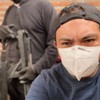A statue of Mexican drug lord
Joaquín “El Chapo” Guzmán is displayed for sale near a bust of narco-saint Jesus Malverde, at his chapel in Culiacan, Sinaloa state in northwest Mexico, on July 16, 2019. Photo: PEDRO PARDO/AFP via Getty Images.
The mayor of Joaquín “El Chapo” Guzmán’s hometown in the state of Sinaloa is planning to open a narco museum to showcase its drug-trafficking history and royalty. All of the main drug lords from the Sinaloa Cartel, including Ismael “El Mayo” Zambada, a co-founder of the Sinaloa Cartel who remains at large, and Rafael Caro Quintero, who was recently arrested and was allegedly behind the killing of a DEA agent, would be brought together in Badiraguato, Sinaloa, promised José Paz López, the town’s mayor. “We can’t deny the history of this town. We shouldn’t be scared by a museum of drug trafficking. And on the contrary, this will bring economic benefit to the city,” Paz said in an interview for Mexican news outlet Milenio. The importance of the drug trade to Sinaloa cannot be overstated, and many there see the likes of El Chapo, El Mayo, and Caro Quintero as local heroes who went from rags to riches through the cocaine, weed, meth, heroin, and fentanyl empires that they built.The mountains of the state are peppered with clandestine weed and heroin poppy plots, as well as labs producing meth and fentanyl. Memorabilia such as caps and T-shirts for sale around the state’s markets feature images of El Chapo and the number 701, which was his place on the Forbes Richest list when he was first featured in 2009.The museum, which will be built on the top of Badiraguato’s main hill, will showcase belongings such as weapons, clothes, and vehicles from the main Sinaloa Cartel leaders, and will have real-sized wax figures of some of them, according to Paz. “The museum will have an area dedicated to drug manufacturing from where we will tell people that doing drugs is not good, that it’s harmful to do drugs,” he said. Paz said that Badiraguato has overcome the stigma of being a “narco-town” and “it is today one of the safest cities in Mexico to visit.”One of Sinaloa’s main tourist destinations is the Jesús Malverde chapel in the capital, Culiacán, which attracts thousands of visitors, from Mexico and abroad, each year. Malverde, a mythical figure in narco culture, is a Robin Hood–esque bandit believed to have robbed from the rich to give to the poor during the 1900s. Visitors go to the chapel to pay their respects and ask Malverde for favors, in return for promises of cash and penance. The chapel also sells a variety of narco souvenirs including key rings, caps, mugs, and T-shirts bearing the names and images of Malverde and other Sinaloa Cartel legends. In the last couple of years, mini statues of El Chapo have also appeared for sale at the chapel. Mexico City already has a little-known drug museum that’s overseen by the Mexican army and not open to the public. It houses a collection of items seized over the years from some of the country’s top drug traffickers, including a diamond-encrusted Colt 45 with El Chapo's initials embossed on it, confiscated during his 2016 arrest.It’s unclear whether the museum in Badiraguato will be entirely funded by government money, or whether there will be some cash injection into the project by some of the state’s private “investors.”
Advertisement
Advertisement
